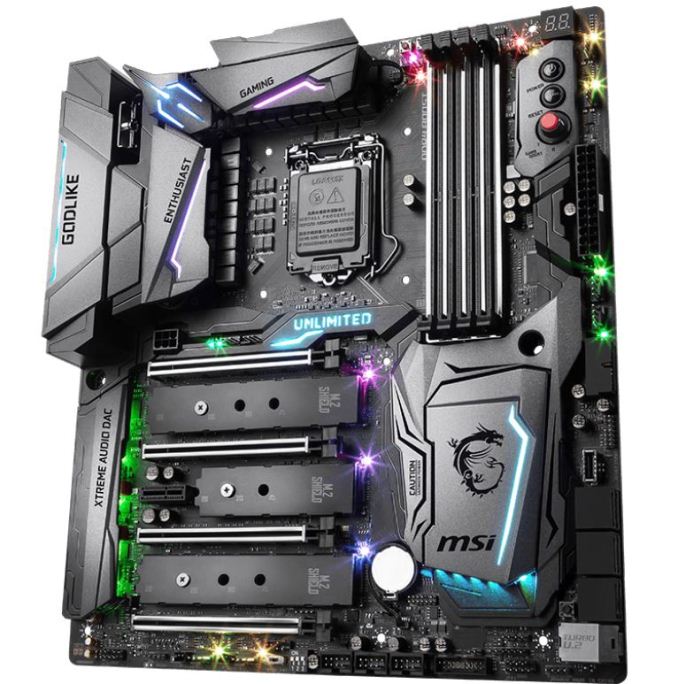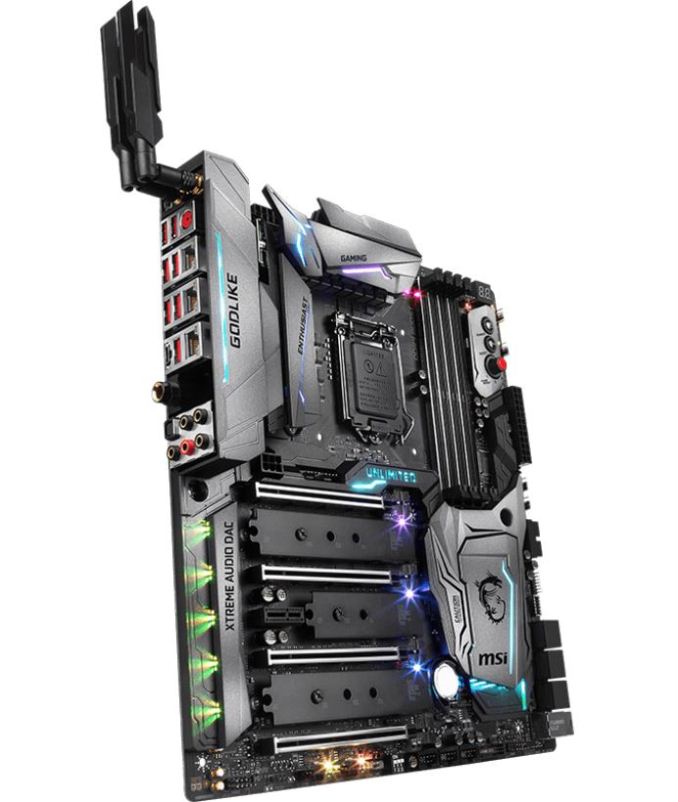Analyzing Z370 for Intel's 8th Generation Coffee Lake: A Quick Look at 50+ Motherboards
by Ian Cutress, Anton Shilov, Joe Shields & Gavin Bonshor on October 20, 2017 2:00 PM ESTOur next board partner in the roundup is MSI. MSI brings ten Z370 motherboards to the table, from the entry-level Z370-A Pro to the flagship Z370 Godlike Gaming. We have divided these up by MSI's existing product stack delineation. We'll start with the Enthusiast Gaming line, then cover Performance Gaming, Arsenal Gaming, and Pro lineups.
MSI Z370 Godlike Gaming
The Godlike Gaming is an E-ATX sized board which comes with a lot of features. One of the first features that stuck out in my mind is a triple Killer E2500 LANs + Killer Wi-Fi, along with U.2 support and support for five M.2 based devices when using the included PCIe riser card. It also comes with a beefy power delivery and a Game Boost knob for easy overclocking. Can we still turn it up to 11? (Ian: yes, it goes up to 11)
The Z370 Godlike Gaming’s appearance is an all-black PCB with dark gray shrouding all over the board. Not only is the back panel IO and audio section covered, so is the right side of the board starting from the chipset heatsink on all the way up to the onboard power, reset, and game boost overclocking buttons. RGB LEDs find their way under these shrouds as well as under the PCH heatsink and miscellaneous places around the board. There are additional headers on the board for adding more RGB, all of which are controlled my MSI’s Mystic Light App. The VRM heatsinks are large hunks aluminum but appear to not be connected to each other. All the full-length PCIe and memory slots are reinforced, as well as the three onboard M.2 slots which are using MSI’s M.2 Shield to help cool the drives.
Memory slot support is the platform standard here as well with four slots supporting up to 64GB, up to a supported speed of DDR4-4133, which is one above the other boards in the product stack which max out at DDR4-4000. All the memory slots are steel reinforced and use a one-sided locking mechanism. The board has a total of four full-length reinforced PCIe slots and one x1 slot, which combined can handle 2-way SLI and up to 4-Way AMD Crossfire. This means that the CPU uses an x8/x4/x4 layout from the processor, using slots 1, 2, and 4, while the bottom full-length slot is from the chipset. Slots 1 and 4 are used in a dual GPU configuration allowing for adequate spacing between the cards for better cooling, so the options become x16/0/0 for single cards, x8/0/x8 for dual cards, and x8/x4/x4 for triple cards.
The storage options on this board are plentiful in number and type. On the board are three PCIe 3.0 x4 M.2 slots, all using MSI's M.2 Shield. There is also a possibility to add two more M.2 drives through an add-in card, which is bundled with the board in certain regions. SATA support runs the same as the other boards at six and supports RAID 0, 1,5, and 10. A fairly unique addition is a single U.2 slot. The M.2 slots, U.2 port, and SATA ports are partly switched (using one might disable something else), so be sure to check the manual for the breakdown.
There are a total of 10 fan headers on the board scattered all around the board; all of which can be controlled via the BIOS or MSI Command Center. Audio functionality is handled by the Realtek ALC1220 codec and includes Nichicon and WIMA audio caps as well as an ESS E9018 DAC for driving headphones. The Z370 Godlike also has a debug LED, power and reset buttons, as well as the Gameboost overclocking knob.
MSI quadrupled down on the Rivet Networks Killer products and have three E2500 NICs on board as well as Killer 1535 Wireless LAN and Bluetooth (4.1) module. This is because the board can act like a networking switch through the updated Killer software: users can have the motherboard act as a passthrough for other devices set up nearby, such as a console or a NAS. In order to enable this feature, Killer required the motherboard to have at least three of its network controllers. If the main internet access is acquired through one of the ethernet ports, the motherboard can use the Wi-Fi module as a local access point to the network, enabling wireless devices around the system. The only drawback to this feature is that the PC needs to be on and awake at all times.
There are three USB3.1 (10 Gbps) ports handled by the ASM3142 controller with one Type-A and one Type-C on the back panel and another Type-C port available through the internal connector. We also see two native USB 3.1 (5Gbps) ports on the rear panel and four controlled by the ASM1074 hub. The rest are available through internal USB connectors. The back panel IO contains the Killer Wi-Fi module, a CMOS reset button, combination PS/2 port, the three Killer NICs, a plug audio stack with SPDIF and a 6.3mm headphone jack. Because the back panel does not have video outputs, a discrete GPU is a requirement for this motherboard.
| MSI Z370 Godlike Gaming | |
| Warranty Period | 3 Years |
| Product Page | Link |
| Price | Amazon US |
| Size | E-ATX |
| CPU Interface | LGA1151 |
| Chipset | Intel Z370 Express |
| Memory Slots (DDR4) | Four DDR4 Supporting 64GB Dual Channel Support DDR4 4133+ |
| Network Connectivity | 3 x Rivet Networks Killer E2500 LAN 1 x Killer 1535 Wi-Fi w/Bluetooth (4.1) |
| Onboard Audio | Realtek ALC1220 |
| PCIe Slots for Graphics (from CPU) | 3 x PCIe 3.0 x16 slots @ x16, x8/0/x8, x8/x4/x4 |
| PCIe Slots for Other (from Chipset) | 1 x PCIe 3.0 x16 slots @ x4 1 x PCIe 3.0 x1 slots @ x1 |
| Onboard SATA | 6 x Supporting RAID 0/1/5/10 |
| Onboard SATA Express | None |
| Onboard M.2 | 3 x PCIe 3.0 x4 - NVMe or SATA |
| Onboard U.2 | 1 x PCIe 3.0 x4 |
| USB 3.1 (10 Gbps) | 1 x Rear Panel Type-C (ASMedia) 1 x Rear Panel Type-A (ASMedia) 1 x Onboard Header |
| USB 3.1 (5 Gbps) | 2 x Rear Panel (Native) 4 x Rear Panel (ASMedia Hub) 2 x Onboard Headers |
| USB 2.0 | 3 x Headers |
| Power Connectors | 1 x 24-pin EATX 1 x 8-pin ATX 12V 1 x 4-pin ATX 12V 1 x 6-pin PCIe |
| Fan Headers | 1 x 4-pin CPU 1 x 4-pin Waterpump 8 x 4-pin System Fan |
| IO Panel | 1 x Clear CMOS button 2 x Wi-Fi Antenna connectors 1 x PS.2 keyboard/mouse port 6 x USB 3.1 (5 GBps) Type-A ports 3 x LAN (RJ45) ports 1 x USB 3.1 Type-C 1 x USB 3.1 Type-A 1 x 6.3mm stereo headphone jack 1 x Optical S/PDIF out 5 x Audio Jacks |













83 Comments
View All Comments
sor - Friday, October 20, 2017 - link
Damn. At least key it differently and call it LGA1151v2 or something.The changes are so minimal it really does seem like planned obsolescence. Does it really need more power pins to support new chips with the same power envelopes? Really? They couldn’t handle that on the CPU PCB?
KaarlisK - Saturday, October 21, 2017 - link
Actually it is ~1.5 times peak current with the same average power envelope, so yes, they need the change.If they had not brought the launch forward and just launched together with the cheap chipsets, there would be far less complaints.
sor - Saturday, October 21, 2017 - link
Where did you find information indicating current has increased 50%? I just spent about ten minutes trying to find a reference backing that up, perhaps something indicating the 8 series operates at a much lower voltage within same TDP, which would translate to higher current but they seem to operate in the same 1.2-1.3v range.You’re not just assuming they draw more current because they have two more cores, are you?
KaarlisK - Sunday, October 22, 2017 - link
Notice the difference between average and peak.And the information is in publicly available documents. I did not bother to look it up, but others have, for example: https://forum.beyond3d.com/threads/intel-coffee-la...
Crono - Saturday, October 21, 2017 - link
Nice roundup. That's a lot of motherboards to spec and summarize. I especially appreciate the handy chart at the end, it's a good, quick-and-dirty comparison tool.Landcross - Saturday, October 21, 2017 - link
You guys forgot 2 new Z370 boards from Supermicro :)https://motherboarddb.com/motherboards/?chipset=19...
Xpl1c1t - Sunday, October 22, 2017 - link
The mITX board looks incredible.+ Low ESR Tantalum capacitors! (first time seeing them on VRM duty on a mainboard)
+ HDMI 2.0
+ 2x M.2 Slots
+ USB 3.1 Type C
+ Optical SPDIF
- RGB.......
MadAd - Saturday, October 21, 2017 - link
Great write up but for me its just another depressing generation of oversized, overpriced ATX form factor offerings on which the vast majority of users wont even plug a second gpu into, with the smaller and more size appropriate FF represented as a minority afterthought.With all the progress of PCs since the 90s whod have thought that I could still use the same ATX case today while every single other component (from floppy drives to 2d Mattrox cards) have long gone to the recyclers. I find it so annoying how manufacturers have stuck on this prehistoric gargantuan case size with the other sizes being an afterthought. It feels like like stifled innovation while everything else is moving on.
rocky12345 - Saturday, October 21, 2017 - link
Great article and a lot of work put in to get it out for us to read thank you.My only issue is and it is nit your fault is why these companies feel the need to totally blanket the market with basically the same boards just a different model number and basically a few tiny changes and spray paint it a different color and use the word gaming and put something x or x1 or k,k3 etc etc. For crap sakes just release three models not 7-10 models of the same crap it is pretty much just greed I guess.
The whole market is like this now with anything computer related of and if it has the words GAMING or RGB in it's got to be good for sure. My fav is that gaming mouse pad next it will have RGB lighting in it...lol
CitizenZer0 - Wednesday, October 25, 2017 - link
Agreed